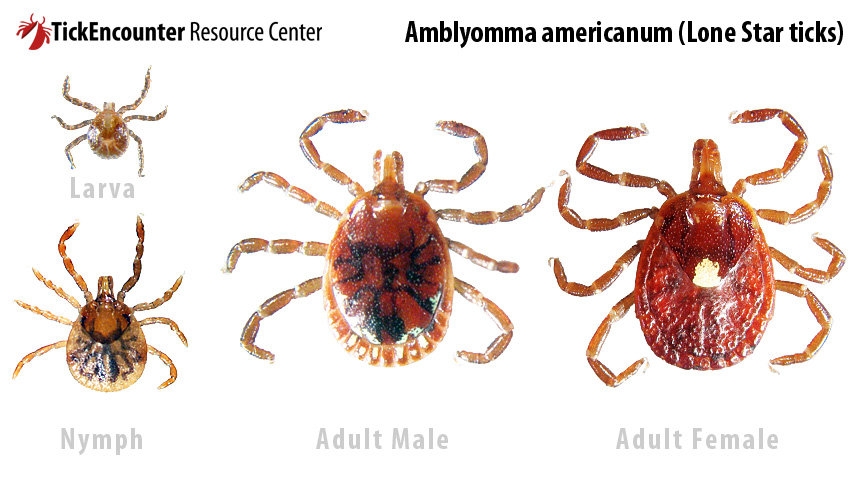A Canadian Perspective on the Red Meat Allergy
This guest post is written by Shaun Dergousoff, PhD, a research scientist at AAFC Lethbridge focused on tick populations and arthropod vectors of livestock disease.
Several recent news articles have reported a connection between tick bites and allergies to red meat products in the United States. This is often framed as an emerging and alarming public health issue, but should it be a concern for the Canadian public and the beef industry?
The “red meat allergy” was first identified in Australia with several hundred cases diagnosed since 1985, and was recognized in thousands of people in the southeastern United States over the last couple decades. This allergy also occurs in fewer people from several other countries around the world. Based on reported cases, it appears that allergy to red meat is about as common as allergy to peanuts, occurring in only 0.1% of the American population. Those who are affected can have very serious and even life-threatening anaphylactic reactions after eating red meat products.
The source of the red meat allergy was a mystery until 2007 when doctors realized that a large proportion of the people that were diagnosed also reported tick bites weeks or months prior to experiencing symptoms.
When a tick attaches to a person or animal (“host”), it will feed on blood for several days if not removed. During this time it also injects saliva, which contains several types of proteins and fats, directly into the host’s bloodstream. Ticks have a few tricks up their sleeves and some of these compounds act as an anaesthetic so the host cannot feel the tick bite. Other compounds injected by the tick alter the host’s immune response. Susceptible people produce antibodies to carbohydrates (sugars) in the ticks’ saliva that are different than the types of carbohydrates found our bodies. One to three months after being exposed to the tick, the host’s primed immune system can produce antibodies to a similar carbohydrate called galactose-alpha-1,3-galactose, more commonly called alpha-gal, which is found in cells of non-primate mammals. The production of antibodies to alpha-gal can lead to allergic reactions in people (“alpha-gal syndrome”).

The allergic reaction occurs 2 to 10 hours after eating red meat (beef, pork, and lamb, but not chicken or fish), or other animal products, such as gelatin and milk. Interestingly, the ticks’ salivary compounds that alter the host’s immune response may have a role in directing it to an allergy type of antibody response to alpha-gal. Symptoms can be relatively mild with hives and swelling, but can also end up as a severe anaphylactic reaction that requires a shot of epinephrine. To diagnose that the allergy is to red meat, doctors use a test that detects antibodies to alpha-gal. Fortunately for some people, the reaction can become less severe or even be eliminated over time if they prevent further exposure to tick bites.
Almost all cases of alpha-gal syndrome in the USA occur in areas where the lone star tick is present, which is mainly in the southeastern states. Fortunately none of the tick species that are currently established in Canada produce the allergy.
The increase in the number of allergy cases, which spurred the recent media reports, may be partly due to changes in lone star tick populations. In some regions the ticks are becoming more abundant. They are also spreading into new areas, with increasing reports of individual ticks and established populations the in northern states, including Michigan, Minnesota and New York. So, it’s likely that the tick will continue to move northward, but this would be limited by the availability of suitable habitat for tick development and survival. Unfortunately no one really knows where this limit occurs and it’s possible that parts of Canada can support lone star tick populations.
Several provincial and national surveillance programs are monitoring the presence of ticks in Canada. Out of the relatively few lone star ticks collected each year in Canada, the majority are from people or dogs that spent time in areas of the USA where this tick normally occurs. Rarely, single lone star ticks are collected directly from the vegetation in eastern Canada. These most likely hitched a ride as immature ticks on migrating birds and fell off a few days after attaching. Up to now, there is no evidence of established populations in Canada. This difference between reported occurrences of a tick and establishment of a population is very important when considering the level of risk to people and how to manage it.
Back to the original question – what does this mean for the public and the beef industry in Canada? Currently, very few lone star ticks are brought into the country and the chance of encountering these ticks is extremely low. On top of that, a relatively small proportion of the population is susceptible to developing the allergy to red meat. So, continue enjoying the great outdoors (while taking precautions to avoid bites from local tick species) and enjoy your Canadian Beef.
Additional Information About the Red Meat Allergy:
- For more information and images of the lone star tick see the Tick Encounter website:
- For information on prevention of tick (and mosquito) bites refer to this article from the Canadian Paediatric Society
- The American College of Allergy, Asthma & Immunology has more information on the red meat allergy
Click here to subscribe to the BCRC Blog and receive email notifications when new content is posted.
The sharing or reprinting of BCRC Blog articles is welcome and encouraged. Please provide acknowledgement to the Beef Cattle Research Council, list the website address, www.BeefResearch.ca, and let us know you chose to share the article by emailing us at [email protected].
We welcome your questions, comments and suggestions. Contact us directly or generate public discussion by posting your thoughts below.